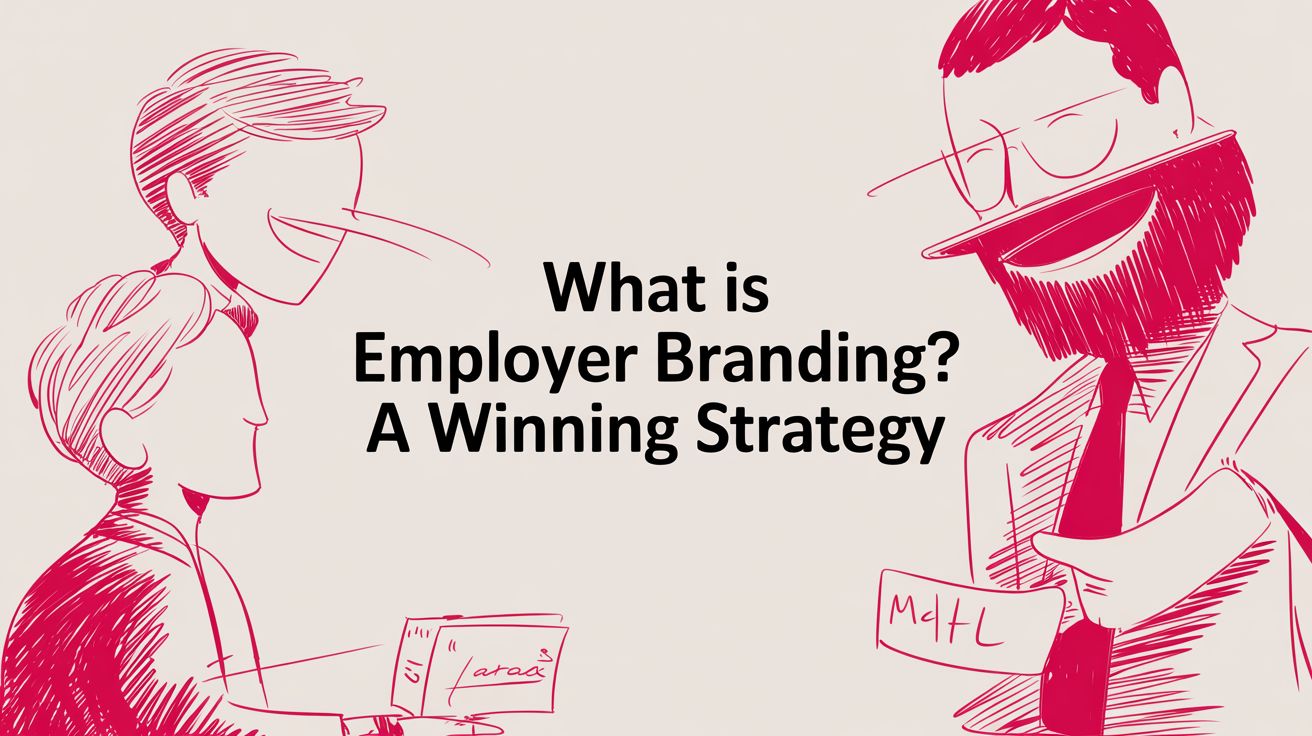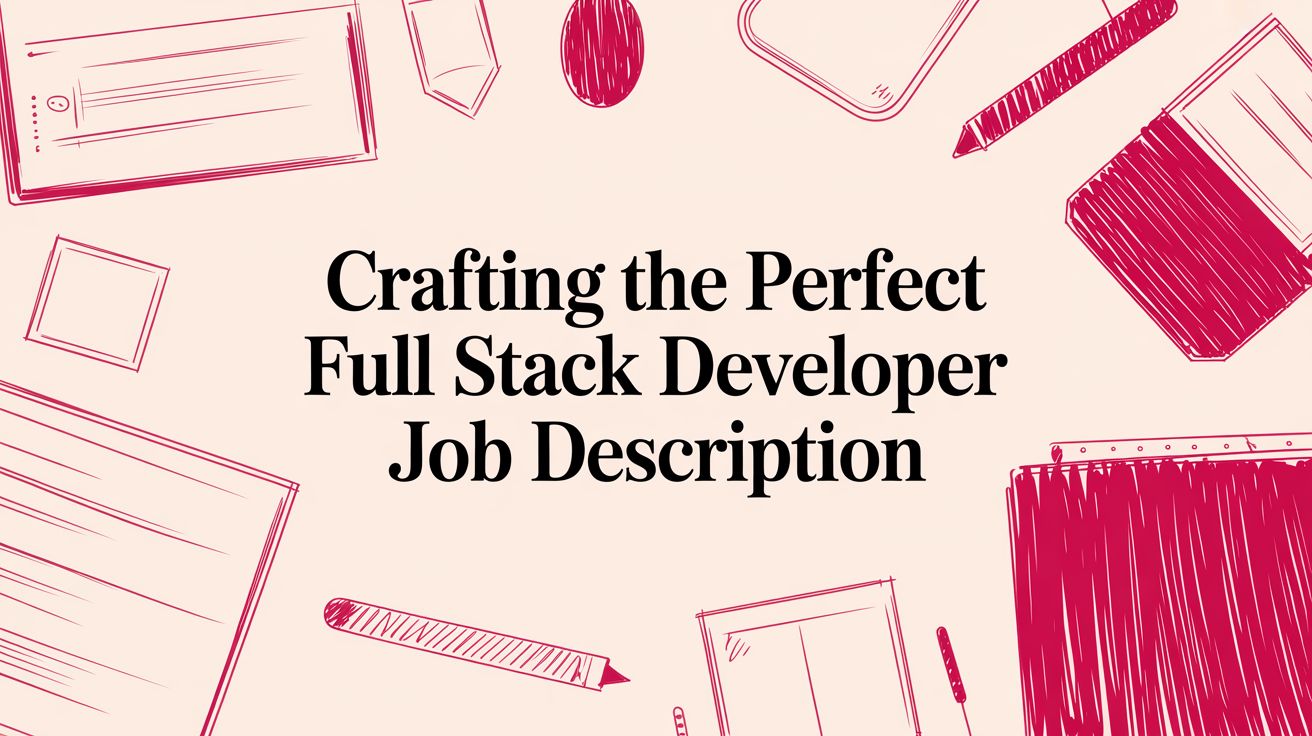What Is Emotional Intelligence at Work?
Max
We throw the term emotional intelligence around a lot, but what does it actually mean when you’re on the clock?
Think of it this way: it’s the ability to tune into your own emotions, figure out what’s driving them, and manage them effectively. But it doesn’t stop there. It’s also about having the antenna up to recognize, understand, and influence the emotions of the people you work with every day.
It’s not some fluffy “soft skill.” It’s more like a powerful human operating system that dictates how you communicate, handle pressure, and ultimately, lead.
Why Emotional Intelligence Is Your Career Superpower
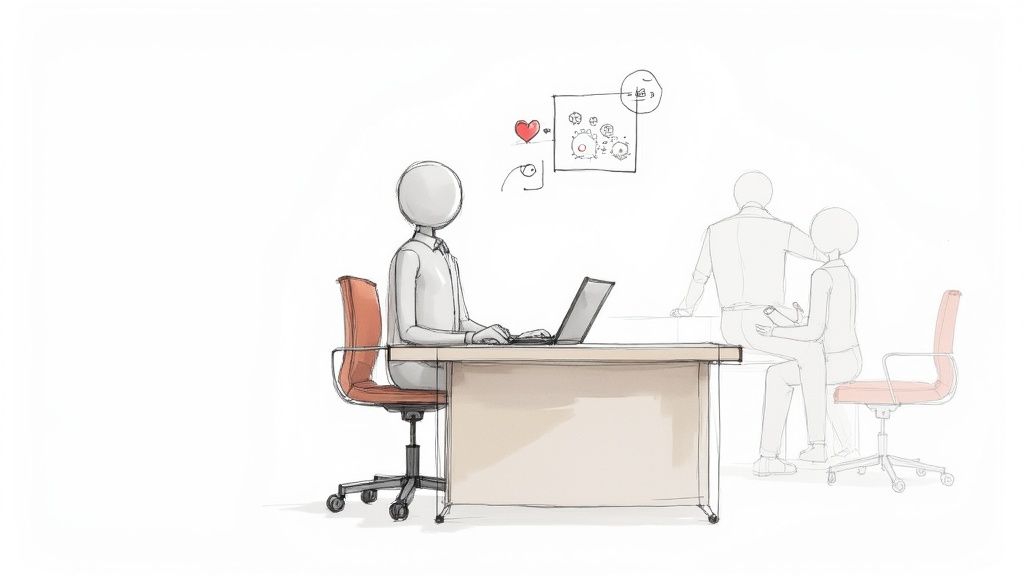
Your technical skills and raw intelligence might get your foot in the door, but your emotional intelligence (EI) is what helps you thrive once you’re inside. It’s the secret sauce for navigating tricky office dynamics, handling stress with grace, and building the kind of genuine relationships that truly propel a career forward.
This isn’t about plastering on a fake smile or burying your feelings. It’s the opposite. It’s about using emotional information as a tool to make smarter decisions. A professional with high EI can read the tension in a virtual meeting, give tough feedback that still feels supportive, and stay cool when a project goes completely sideways. That ability is a massive predictor of success.
The Real-World Impact of EI
The numbers don’t lie. Research shows that emotional intelligence is a huge piece of the puzzle, accounting for around 58% of job performance across all industries.
Even more telling? A staggering 90% of top performers are recognized for their high emotional intelligence. It’s clearly what separates the good from the truly great.
“Emotional intelligence is the ability to make emotions work for you, instead of against you. It’s about being smarter with feelings.”
To give you a better feel for how this plays out in day-to-day work life, here’s a quick comparison of low versus high EI responses in common situations.
Emotional Intelligence at a Glance
| Scenario | Low Emotional Intelligence Response | High Emotional Intelligence Response |
|---|---|---|
| Receiving Critical Feedback | Becomes defensive, blames others, or dismisses the feedback entirely. | Listens openly, asks clarifying questions, and sees it as an opportunity to grow. |
| A High-Pressure Deadline | Panics, gets easily frustrated, and their stress negatively affects the team. | Stays calm, prioritizes tasks logically, and communicates clearly to manage team anxiety. |
| Team Conflict | Avoids the issue, takes sides, or lets frustration escalate the situation. | Acts as a mediator, seeks to understand both perspectives, and facilitates a constructive solution. |
| A Colleague Is Upset | Ignores their colleague’s feelings or offers generic, unhelpful advice. | Shows empathy, actively listens to understand the root cause, and offers genuine support. |
As you can see, the high-EI approach consistently leads to better outcomes, stronger relationships, and a more positive work environment.
More Than Just a Buzzword
At its core, emotional intelligence is the bedrock for so many other crucial skills. You simply can’t excel in certain areas without a solid emotional quotient (EQ).
For instance, high EI is directly tied to your ability to:
- Build Trust: Real connection comes from empathy and understanding—the cornerstones of EI.
- Resolve Conflict: You can’t de-escalate a tense situation without regulating your own emotions and seeing things from the other person’s view.
- Inspire Teams: The best leaders connect with their people on an emotional level, which is what builds true loyalty and engagement.
Growing these skills is also a huge part of becoming a more effective and empathetic leader. To dig deeper into that connection, check out our guide on what is inclusive leadership and see how it all ties together.
Breaking Down the Five Pillars of EI
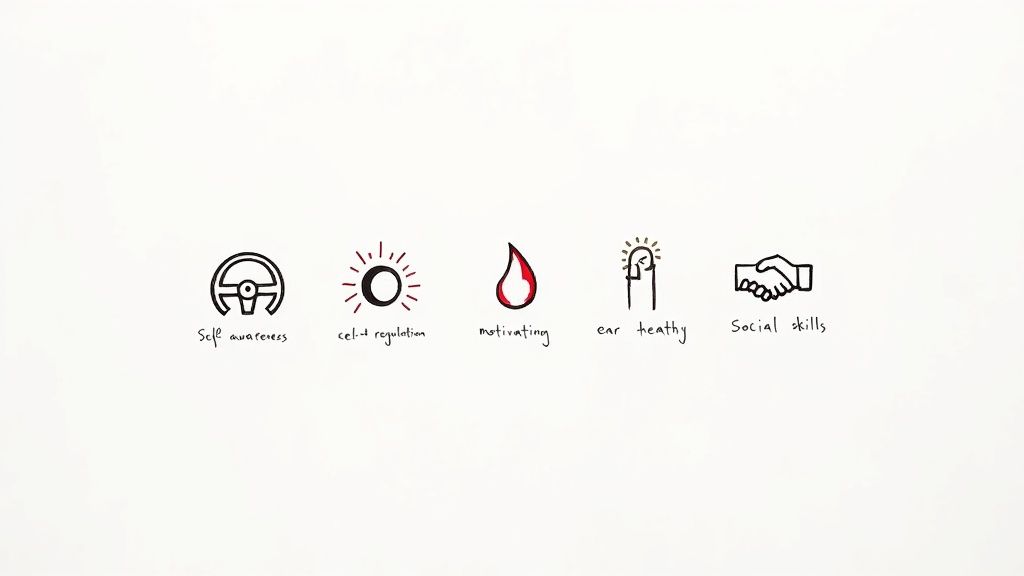
Emotional intelligence isn’t one single, monolithic skill. Think of it more like a powerful toolkit with five distinct, interconnected tools. Getting a handle on each one gives you a clear roadmap to see where you shine and where you have room to grow.
These pillars are the bedrock of what emotional intelligence is at work. When you get good at using them together, you’re much better equipped to navigate the tricky, complex dynamics that pop up in any workplace.
Let’s unpack each one.
1. Self-Awareness: The Internal Dashboard
Self-awareness is the absolute cornerstone of EI. It’s your ability to recognize and truly understand your own moods, emotions, and what drives you—and, crucially, how all of that affects other people. It’s like having an internal dashboard giving you real-time data on your own state of mind.
A self-aware professional knows their own triggers. They can pinpoint that a tight project deadline sends their stress levels soaring or that they feel most energized during a creative brainstorm. This kind of clarity is the essential first step to managing your own behavior and reactions.
Without it, you’re basically flying blind.
2. Self-Regulation: The Cruise Control
Once you can read your internal dashboard, self-regulation is what lets you do something with that information. This is your ability to control or redirect those disruptive impulses and moods. It’s your emotional cruise control, keeping you steady even when the road gets bumpy.
For example, you get some frustrating feedback on a project. Self-regulation is the skill that stops you from firing off a knee-jerk, angry email. Instead, it helps you pause, process the feedback, and craft a calm, constructive response. It’s not about bottling up your feelings, but about managing them so they don’t end up managing you.
Self-regulation is the difference between reacting impulsively and responding thoughtfully. It’s a critical skill for maintaining professionalism and making sound decisions under pressure.
3. Motivation: The Internal Drive
In the world of EI, motivation is about a passion for work that goes way beyond a paycheck or a fancy title. It’s that inner drive to chase down goals with energy and persistence. Emotionally intelligent people are often self-motivated, driven by a deep desire to achieve for the simple sake of achievement.
This pillar is what keeps you optimistic and resilient, even when things go wrong. When a major project fails, this internal motivation helps you frame it as a learning opportunity instead of a personal defeat. It’s what lets you bounce back with purpose.
4. Empathy: The Social Antenna
Empathy is your ability to understand the emotional landscape of other people. It’s like a social antenna, allowing you to tune into the feelings and perspectives of your colleagues, clients, and team members.
This is a non-negotiable skill for anyone working in a team. It allows you to:
- Read the room: Sense when a coworker is overwhelmed or when the team’s morale is dipping.
- Give better feedback: Frame your message in a way the other person can actually hear and accept.
- Build real relationships: Show others that you genuinely see and value their point of view.
Empathy is what helps you connect with people on a human level, building the trust that’s essential for great teamwork.
5. Social Skills: The Relationship Manager
Finally, social skills bring all the other pillars together. This is your knack for managing relationships, building networks, and finding common ground to build rapport.
This skill isn’t just about being a social butterfly; it’s about being effective. People with strong social skills are great at persuasion, leading teams, and navigating conflict because they know how to steer conversations toward productive outcomes.
As you can probably guess, this is all deeply tied to communication. If you want to dive deeper, you can explore some practical strategies on how to improve communication skills at work in our detailed guide.
The Undeniable Benefits of a High EQ
Knowing the building blocks of emotional intelligence is one thing, but seeing how it actually plays out in the real world is where it all clicks. Building a high EQ isn’t just a nice-to-have for personal growth; it’s a serious career strategy that pays off for both you and your company. Think of it as the engine powering better decisions, stronger teams, and a more resilient workforce.
Professionals who get a handle on their emotional intelligence are simply better prepared for the inevitable pressures of the workplace. They don’t just survive stress—they manage it, making them the calm, reliable leaders you want in your corner when things get tough. That ability to stay level-headed is the secret to making smarter, more thoughtful decisions.
This skill set is also what separates good teams from great ones. When team members can actually understand where others are coming from and communicate with genuine self-awareness, small disagreements get resolved before they snowball into major problems. This creates a more cohesive and innovative environment where people feel safe enough to bring their best ideas to the table.
Driving Performance and Engagement
The link between emotional intelligence and career success isn’t just theory—it’s backed by real results. Time and again, emotionally intelligent employees perform better, build more robust professional networks, and are the ones tapped for leadership roles. Their knack for inspiring and connecting with people makes them natural influencers, no matter what their job title is.
And the benefits for companies are just as powerful. Research from the Yale Center for Emotional Intelligence shows that employees with higher EQ report being more satisfied with their jobs and feeling less burned out. They’re also better at building collaborative relationships, which naturally leads to a more harmonious and productive workplace. You can dive deeper into the findings on workplace success from Yale.
This direct impact on morale translates straight to the bottom line. A more engaged and satisfied team leads to:
- Higher Productivity: When people communicate and collaborate well, they just get more done. It’s that simple.
- Reduced Turnover: Employees who feel understood and supported don’t look for the exit. They stick around.
- Improved Customer Relations: EQ gives you the empathy to truly connect with and respond to clients’ needs.
At the end of the day, a high EQ is a major predictor of long-term success. For any organization serious about keeping its top talent, developing these skills isn’t optional. For more on this, check out our guide on how to improve employee retention.
Investing in emotional intelligence isn’t just about fostering a positive culture; it’s a direct investment in performance, leadership, and organizational resilience. A high EQ provides the foundation for navigating complexity and driving sustainable growth in any industry.
Putting Emotional Intelligence Into Practice

Knowing the theory behind emotional intelligence is one thing. Actually using it when you’re under pressure and emotions are running high? That’s a completely different ballgame.
This is where EI truly shines. It’s the secret ingredient that turns a conversation spiraling out of control into one that leads to a genuine breakthrough. Let’s walk through a few common workplace headaches and see how a high-EI approach can completely change the outcome.
H3: Scenario 1: Giving Difficult Feedback
You have to give feedback to a colleague you like, but their work quality has recently slipped. It’s the kind of conversation most of us dread, but it has to happen.
- Low-EI Reaction: You put it off for weeks. When you finally do it, you rush through the conversation with vague comments like, “You really need to step it up.” This leaves your colleague feeling confused, defensive, and with zero idea of how to actually improve.
- High-EI Approach: You start the conversation by reminding them how much you value their contributions (social skill). You then bring up specific, fact-based examples of the performance issues—without judgment (self-regulation)—and then you genuinely listen to their side of the story (empathy). The entire conversation is framed as a collaboration, not a criticism.
This empathetic approach transforms a potential conflict into a supportive, problem-solving session. For more practical advice, our guide on how to handle difficult conversations offers some great frameworks.
H3: Scenario 2: A Stakeholder Keeps Changing Their Mind
Picture this: you’re leading a project, but a key stakeholder keeps moving the goalposts. The constant changes are causing delays and your team is getting seriously frustrated.
- Low-EI Reaction: Your annoyance is obvious in meetings. You complain about the stakeholder to your team and maybe even send a few passive-aggressive emails. This just creates a toxic atmosphere and damages the relationship, putting the project in even more jeopardy.
- High-EI Approach: You feel the frustration bubble up, but you don’t act on it (self-regulation). Instead, you schedule a one-on-one to understand the why behind the changes (empathy). By asking curious questions instead of accusatory ones, you uncover the real issue and can work with them to find a more stable path forward.
Emotional intelligence is a game-changer for improving team dynamics and navigating workplace relationships effectively. It gives you the tools to manage stress and build stronger professional bonds, even when personalities clash.
H3: Scenario 3: A Team Debate Gets Heated
During a brainstorming session, two team members start arguing. It quickly becomes personal, the tension is thick, and the meeting has been completely derailed.
- Low-EI Reaction: You either shut it down completely (“Okay, let’s just move on”) or, even worse, you take a side. Both options leave the root issue simmering under the surface and crush team morale.
- High-EI Approach: You step in as a calm, neutral mediator (social skill). You acknowledge both points of view with something like, “I can see you both feel strongly about this. Let’s pause for a second and make sure we’re hearing each other out.” By validating their feelings and gently redirecting the focus back to the team’s shared goals, you pull the conversation back from the brink.
In every one of these situations, high emotional intelligence isn’t about being “nice” or avoiding conflict. It’s about facing challenges head-on with intention, managing your own reactions, and using empathy to build bridges instead of walls. That’s how you build stronger, more resilient teams.
Practical EI Strategies for Common Challenges
To make this even more concrete, here are some actionable strategies you can apply to common workplace situations. Think of this as your EI cheat sheet.
| Challenge | Key EI Pillar to Use | Actionable Strategy |
|---|---|---|
| Feeling Overwhelmed by Your Workload | Self-Regulation | Pause and take five deep breaths before reacting. Prioritize your top 3 tasks for the day and focus only on the first one. |
| Misunderstanding a Colleague’s Tone via Email | Empathy | Instead of assuming negative intent, pick up the phone or start a video call. Ask clarifying questions like, “Can you help me understand…?” |
| Receiving Vague, Unhelpful Feedback | Social Skill | Ask for specific examples. Say, “I appreciate the feedback. Could you give me an example of when I did X so I can improve?” |
| Leading a Team Through a Stressful Change | Motivation & Empathy | Acknowledge the team’s anxiety openly. Then, clearly communicate a positive, shared vision for the future to keep everyone focused and motivated. |
Applying these techniques consistently will help you build your emotional intelligence muscles, making you a more effective and respected leader and teammate.
A Practical Guide to Developing Your EI
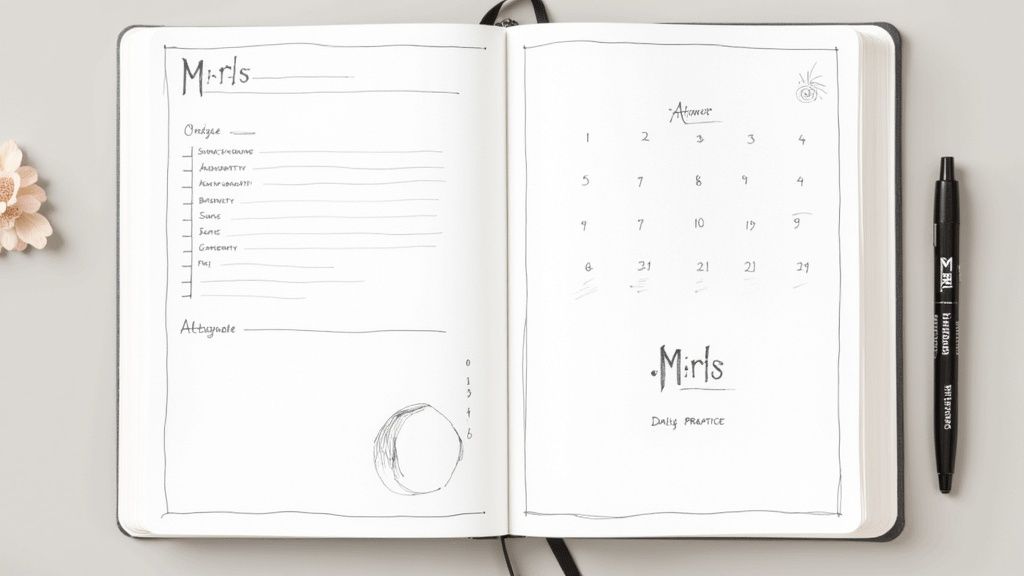
Here’s the great news about emotional intelligence: it isn’t some fixed trait you’re either born with or not. It’s a skill. And just like any other skill, you can build it up with a bit of intentional practice. This is your roadmap for doing exactly that, filled with strategies you can start using today.
The whole journey begins by looking inward. You can’t manage what you don’t understand, which makes self-awareness the foundational first step.
A simple way to start is with a daily reflection habit. At the end of each workday, just ask yourself two questions:
- When did I feel a strong positive emotion today? What was happening?
- When did I feel a strong negative emotion? What was the trigger?
This simple act of noticing connects the dots between events and your emotional reactions, revealing patterns you might otherwise miss. Before long, you’ll become much more tuned in to your own internal signals.
Building Your Skills Pillar by Pillar
Once you have a better handle on self-awareness, you can start strengthening the other pillars. Self-regulation, for example, is all about creating a gap between feeling an emotion and acting on it.
When you feel that spike of frustration rising, try a simple technique like the 5-second rule: before you speak or type a single word, take one deep breath and count to five. That tiny pause is often all you need to shift from a knee-jerk reaction to a thoughtful response.
Empathy, on the other hand, is built through genuine, active listening. In your next team meeting, try focusing 100% on what a colleague is saying without planning your reply. Listen to understand their perspective, their concerns, and the feelings behind their words. Then, paraphrase what you heard back to them—”So, what I’m hearing is…“—to confirm you got it right and show you’re truly engaged.
Developing emotional intelligence is no longer just a personal growth exercise; it’s a strategic career move. As routine tasks become automated, skills like empathy and communication are forecasted to grow in demand by 26% by 2030.
Despite this, only 42% of organizations currently offer training to develop these crucial skills. This creates a huge opportunity for professionals who take the initiative to build their own EI. You can find more surprising statistics about emotional intelligence on Apollotechnical.com.
Creating a Personal Development Plan
To make real, lasting progress, you need a simple, focused plan. Don’t try to master all five pillars at once—you’ll just get overwhelmed.
Instead, pick one area to focus on for a month. If you want to improve your social skills, set a small, achievable goal. Maybe you’ll make a point to offer help to one colleague each week or to recognize someone’s contribution in a team channel.
A huge part of this process is asking for input. It’s almost impossible to see our own blind spots, which is why feedback is pure gold. For some great, actionable advice on this, our guide on how to ask for feedback at work gives you a clear and effective framework.
By combining self-reflection with honest feedback from others, you create a powerful cycle of continuous improvement that will strengthen your ability to connect, influence, and lead.
Of course. Here is the rewritten section, crafted to sound completely human-written and natural, following all your specific instructions.
Common Questions About Emotional Intelligence
Once you start digging into emotional intelligence at work, a few questions always seem to come up. It’s totally normal. Busting these common myths is the key to actually using what you’ve learned with confidence.
Let’s clear the air on some of the most frequent ones. This isn’t about memorizing dictionary definitions—it’s about getting comfortable with the real-world messy parts of putting EI into practice.
Is Emotional Intelligence Just Being Nice?
This is probably the biggest misconception out there. While being kind is a great quality, emotional intelligence is way more strategic and complex than just being “nice.” It’s definitely not about bottling up your own feelings or just agreeing with everyone to keep the peace.
Think of it this way: EI is about recognizing an emotion—maybe it’s frustration in a meeting or a disagreement over a project’s direction—and then choosing the most productive way to handle it. Someone with high emotional intelligence can give tough feedback or challenge an idea directly and constructively. That might not feel “nice” in the moment, but it’s always more effective. It’s about being clear and honest while still making the other person feel seen and respected.
Can You Measure Emotional Intelligence?
Yep, you can, though it’s not as straightforward as an IQ test. There are formal assessments out there, like the Mayer-Salovey-Caruso Emotional Intelligence Test (MSCEIT), which measures how well you perceive, use, understand, and manage emotions.
But for day-to-day purposes, a more practical way to get a read on your EI is through a combination of self-reflection and asking for feedback.
- Self-Assessment: Get in the habit of asking yourself how you handled a tough situation. Did you shoot from the hip with a reactive comment, or did you pause and respond thoughtfully?
- 360-Degree Feedback: This is gold. Ask a few trusted colleagues, your manager, and maybe even your direct reports for honest feedback on your communication and conflict-resolution skills. This gives you a priceless look at how your emotional intelligence actually lands with other people.
Don’t think of emotional intelligence as a fixed score. It’s a dynamic set of skills you can work on forever. Measurement isn’t about getting a number; it’s about spotting the specific areas where you can grow.
Can You Have Too Much Empathy?
It sounds counterintuitive, but surprisingly, yes. Empathy is a cornerstone of EI, but when it’s not balanced with self-regulation, it can backfire. You can end up with “empathy fatigue” or full-blown burnout. This is what happens when you soak up all the stress and negative vibes from your team until it starts wrecking your own well-being and clouding your judgment.
The sweet spot is what’s called compassionate empathy. It’s different from emotional contagion. It means you can understand and genuinely care about what someone else is going through without taking on their emotions as your own. This allows you to support them from a place of strength and objectivity, protecting your own energy so you can keep showing up for your team. Nailing that balance is a huge part of mastering EI at work.
Ready to find a role where emotional intelligence is valued? Remote First Jobs connects you with verified remote-first companies looking for skilled professionals like you. Find your next opportunity today
